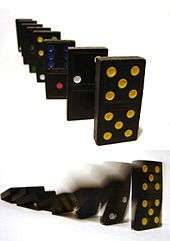Domino effect
A domino effect or chain reaction is the cumulative effect produced when one event sets off a chain of similar events.[1] The term is best known as a mechanical effect and is used as an analogy to a falling row of dominoes. It typically refers to a linked sequence of events where the time between successive events is relatively small. It can be used literally (an observed series of actual collisions) or metaphorically (causal linkages within systems such as global finance or politics). The term domino effect is used both to imply that an event is inevitable or highly likely (as it has already started to happen), and conversely to imply that an event is impossible or highly unlikely (the one domino left standing).


Demonstration of the effect
The domino effect can easily be visualized by placing a row of dominoes upright, each separated by a small distance. Upon pushing the first domino, the next domino in line will be knocked over, and so on, thus firing a linear chain in which each domino's fall is triggered by the domino immediately preceding it. The effect is the same regardless of the length of the chain. The energy used in this chain reaction is the potential energy of the dominoes due to them being in a metastases state; when the first domino is toppled, the energy transferred by the fall is greater than the energy needed to knock over the following domino, and so on.
The domino effect is exploited in Rube Goldberg machines.
Appearances in media
- Domino Day – world record attempt for the highest number of toppling domino stones.
See also
Relevant physical theory:
Mathematical theory
Political theory
Social
References
- "domino effect". The Free Dictionary. Farlex, Inc. Retrieved 29 September 2014.
| Wikimedia Commons has media related to Domino effect. |
Further reading
- Impact Mechanics, W. J. Stronge, Cambridge University Press, 2004, ISBN 0-521-60289-0, ISBN 978-0-521-60289-1